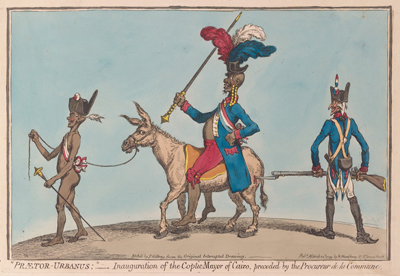'Praetor-Urbanus': Inauguration of the Coptic Mayor of Cairo
This is one of six prints from the series, Egyptian Sketches, created by Gillray in response to the French invasion of Egypt by Napoleon. For more information about the series as a whole, see my commentary on the title page, Egyptian Sketches.
The complete title of this "Sketch" is 'Praetor-Urbanus': Inauguration of the Coptic Mayor of Cairo, preceded by the Procureur de la Commune.

[March 12, 1799]
© Beinecke Rare Book and Manuscript Library, Yale University
When Napoleon invaded Egypt, he proclaimed himself a liberator, freeing downtrodden Egyptians from the long and onerous rule of the Mamelukes, and offering them the benefits of western institutions and government.
Henceforth, no Egyptian shall be excluded from high office, and all shall be able to reach the highest positions; those who are the most intelligent, educated, and virtuous shall govern . . . Happy, thrice happy are those who side with us; they shall prosper in rank and fortune. . . But woe, woe to those who side with the Mamelukes and help them to make war on us. There shall be no salvation for them, and their memory shall be wiped out.*
In Praetor Urbanus Gillray offers another view of how this policy might have worked out in practice.
The Praetor Urbanus in ancient Rome was a city-bound (urban) magistrate who was responsible for the administration of justice in disputes among citizens. As the Romans added to their empire, they increased the number of Praetors to administer Roman law in the new regions. So it makes some sense for Gillray to call the new mayor of the capital city of Cairo a Praetor Urbanus.
But given Gillray's central figure, the Latin title only serves to emphasize the incongruity between the lofty-sounding classical model and this pathetic instance. For in this case, the Praetor is a thoroughly laughable figure. His inaugural procession consists of but four figures: himself, the ass upon which he rides, his public prosecutor, and a typically emaciated French infantryman.
The French investment in this scheme is suggested by the clothing (or lack thereof) of the Praetor and his assistant. The Praetor himself has been given what looks like a cast-off and ill-fitting uniform from a French soldier. The ungainly plumes of his ceremonial hat emerge from his head like asses ears. And far from being the best and brightest, he seems blissfully unaware that he is holding the sceptre of his office upside down. Thankfully Justice is blind because the Public Prosecutor ("Procureur de la Commune") in this new government has been given even less to cover himself than the Praetor. His ceremonial robes consist of a hat and a tri-colored sash.
But the final sign of the limitations of Egyptian freedom in this new world is the French infantryman with his gun and bayonet. He's the only one armed with a weapon and a brain, and he seems delighted with his power to literally "stick it to" an Egyptian ass.
* From Naploeon's proclamation to the Egyptians quoted in Robert Harvey's The War of Wars 2006, pp 235-236.
Sources and Reading
- Commentary from the British Museum on 'Praetor-Urbanus': Inauguration of the Coptic Mayor of Cairo.
- "French campaign in Egypt and Syria," Wikipedia
- The Napoleonic Invasion of Egypt
- "Praetor," Wikipedia
- "Copts," Wikipedia
- Thomas Wright and R.H. Evans, Historical and Descriptive Account of the Caricatures of James Gillray #224
- Thomas Wright and Joseph Grego, The Works of James Gillray, the Caricaturist; With the History of His Life and Times p. 256-257.
Comments & Corrections
NOTE: Comments and/or corrections are always appreciated. To make that easier, I have included a form below that you can use. I promise never to share any of the info provided without your express permission.